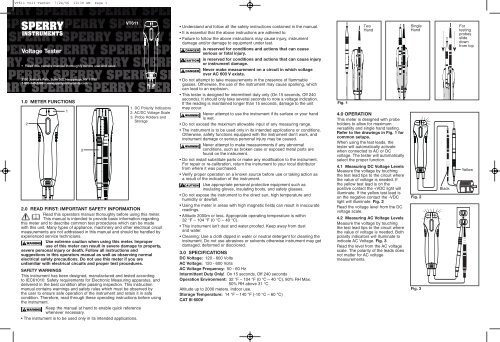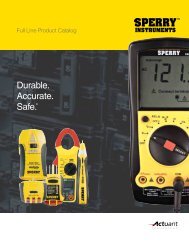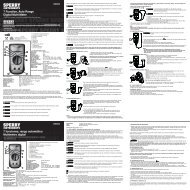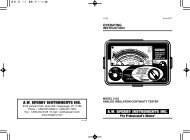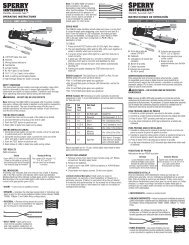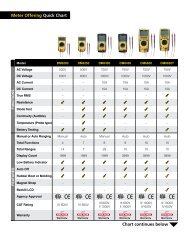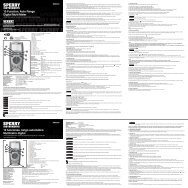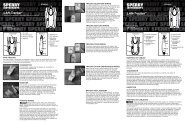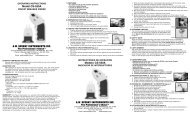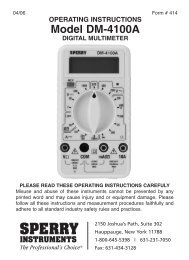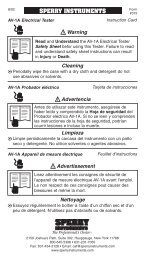Sperry Instruments
Sperry Instruments
Sperry Instruments
Create successful ePaper yourself
Turn your PDF publications into a flip-book with our unique Google optimized e-Paper software.
VT611 Volt Tester 7/24/06 10:39 AM Page 1<br />
SPERRY<br />
INSTRUMENTS<br />
Voltage Tester<br />
• Read this owners manual thoroughly before use and save.<br />
2150 Joshua’s Path, Suite 302, Hauppauge, NY 11788<br />
1-800-645-5398 • www.sperryinstruments.com<br />
1.0 METER FUNCTIONS<br />
2<br />
VT611<br />
2.0 READ FIRST: IMPORTANT SAFETY INFORMATION<br />
Read this operators manual thoroughly before using this meter.<br />
This manual is intended to provide basic information regarding<br />
this meter and to describe common test procedures which can be made<br />
with this unit. Many types of appliance, machinery and other electrical circuit<br />
measurements are not addressed in this manual and should be handled by<br />
experienced service technicians.<br />
! WARNING<br />
Use extreme caution when using this meter. Improper<br />
use of this meter can result in severe damage to property,<br />
severe personal injury or death. Follow all instructions and<br />
suggestions in this operators manual as well as observing normal<br />
electrical safety precautions. Do not use this meter if you are<br />
unfamiliar with electrical circuits and proper test procedures.<br />
SAFETY WARNINGS<br />
This instrument has been designed, manufactured and tested according<br />
to IEC61010: Safety requirements for Electronic Measuring apparatus, and<br />
delivered in the best condition after passing inspection. This instruction<br />
manual contains warnings and safety rules which must be observed by<br />
the user to ensure safe operation of the instrument and retain it in safe<br />
condition. Therefore, read through these operating instructions before using<br />
the instrument.<br />
! WARNING<br />
1<br />
Keep the manual at hand to enable quick reference<br />
whenever necessary.<br />
• The instrument is to be used only in its intended applications.<br />
3<br />
1. DC Polarity Indicators<br />
2. AC/DC Voltage Scale<br />
3. Probe Holders and<br />
Storage<br />
• Understand and follow all the safety instructions contained in the manual.<br />
• It is essential that the above instructions are adhered to.<br />
• Failure to follow the above instructions may cause injury, instrument<br />
damage and/or damage to equipment under test.<br />
! DANGER<br />
! DANGER<br />
is reserved for conditions and actions that can cause<br />
serious or fatal injury.<br />
is reserved for conditions and actions that can cause injury<br />
or instrument damage.<br />
Never make measurement on a circuit in which voltage<br />
over AC 600 V exists.<br />
• Do not attempt to take measurements in the presence of flammable<br />
gasses. Otherwise, the use of the instrument may cause sparking, which<br />
can lead to an explosion.<br />
• This tester is designed for intermittent duty only (On 15 seconds, Off 240<br />
seconds). It should only take several seconds to note a voltage indication.<br />
If the reading is maintained longer than 15 seconds, damage to the unit<br />
may occur.<br />
! WARNING<br />
Never attempt to use the instrument if its surface or your hand<br />
is wet.<br />
• Do not exceed the maximum allowable input of any measuring range.<br />
• The instrument is to be used only in its intended applications or conditions.<br />
Otherwise, safety functions equipped with the instrument don’t work, and<br />
instrument damage or serious personal injury may be caused.<br />
! WARNING<br />
Never attempt to make measurements if any abnormal<br />
conditions, such as broken case or exposed metal parts are<br />
found on the instrument.<br />
• Do not install substitute parts or make any modification to the instrument.<br />
For repair or re-calibration, return the instrument to your local distributor<br />
from where it was purchased.<br />
• Verify proper operation on a known source before use or taking action as<br />
a result of the indication of the instrument.<br />
Use appropriate personal protective equipment such as<br />
insulating gloves, insulating boots, and safety glasses.<br />
• Do not expose the instrument to the direct sun, high temperature and<br />
humidity or dewfall.<br />
• Using the meter in areas with high magnetic fields can result in inaccurate<br />
readings.<br />
• Altitude 2000m or less. Appropriate operating temperature is within<br />
32 °F – 104 °F (0 °C – 40 °C).<br />
• This instrument isn’t dust and water proofed. Keep away from dust<br />
and water.<br />
• Cleaning: Use a cloth dipped in water or neutral detergent for cleaning the<br />
instrument. Do not use abrasives or solvents otherwise instrument may get<br />
damaged, deformed or discolored.<br />
3.0 SPECIFICATIONS<br />
DC Voltage: 120 - 600 Volts<br />
AC Voltage: 120 - 600 Volts<br />
AC Voltage Frequency: 50 - 60 Hz<br />
Intermittent Duty Only! On 15 seconds, Off 240 seconds<br />
Operation Environment: 32 °F – 104 °F (0 °C – 40 °C), 80% RH Max.<br />
50% RH above 31 °C<br />
Altitude up to 2000 meters. Indoor use.<br />
Storage Temperature: 14 °F – 140 °F (-10 °C – 60 °C)<br />
CAT III 600V<br />
Fig. 1<br />
Two<br />
Hand<br />
4.0 OPERATION<br />
This meter is designed with probe<br />
holders to allow for maximum<br />
versatility and single hand testing.<br />
Refer to the drawings in Fig. 1 for<br />
common setups.<br />
When using the test leads, the<br />
tester will automatically activate<br />
when connected to AC or DC<br />
voltage. The tester will automatically<br />
select the proper function.<br />
4.1 Measuring DC Voltage Levels<br />
Measure the voltage by touching<br />
the test lead tips to the circuit where<br />
the value of voltage is needed. If<br />
the yellow test lead is on the<br />
positive contact the +VDC light will<br />
illuminate. If the yellow test lead is<br />
on the negative contact the -VDC<br />
light will illuminate. Fig. 2<br />
Read the voltage level from the DC<br />
voltage scale.<br />
4.2 Measuring AC Voltage Levels<br />
Measure the voltage by touching<br />
the test lead tips to the circuit where<br />
the value of voltage is needed. Both<br />
polarity indicators will illuminate to<br />
indicate AC Voltage. Fig. 3<br />
Read the level from the AC voltage<br />
scale. The polarity of the leads does<br />
not matter for AC voltage<br />
measurements.<br />
Single<br />
Hand<br />
Fig. 2<br />
Fig. 3<br />
Black<br />
For<br />
testing<br />
probes<br />
slide<br />
down<br />
from top<br />
Yellow
VT611 Volt Tester 7/24/06 10:39 AM Page 2<br />
SPERRY<br />
INSTRUMENTS<br />
Probador de Voltaje<br />
• Lea este manual del propietario totalmente antes del uso y ahorre.<br />
2150 Joshua's Path, Suite 302, Hauppauge, NY 11788<br />
1-800-645-5398 • www.sperryinstruments.com<br />
1.0 FUNCIONES DEL MEDIDOR<br />
2<br />
VT611<br />
2.0 LEER PRIMERO: INFORMACIÓN IMPORTANTE DE<br />
SEGURIDAD<br />
Lea este manual del operador totalmente antes de usar este<br />
medidor. Este manual está destinado a brindar información<br />
básica referente a este medidor y a describir procedimientos comunes de<br />
prueba que pueden realizarse con esta unidad. Muchos tipos de mediciones<br />
de circuitos eléctricos, artefactos y maquinarias no se describen en este<br />
manual y deben realizarlas los técnicos de servicio experimentados.<br />
! ¡ADVERTENCIA!<br />
1<br />
3<br />
1. Indicadores de<br />
polaridad de CC<br />
2. Escala de voltaje de<br />
CA/CC<br />
3. Portasondas y<br />
almacenamiento<br />
Tenga sumo cuidado al utilizar este medidor. El uso<br />
indebido de este medidor puede producir graves daños<br />
materiales, además de lesiones físicas serias o fatales. Siga todas las<br />
instrucciones y sugerencias en este manual del operador y observe<br />
también las precauciones de seguridad normales con la electricidad.<br />
No use este medidor si no está familiarizado con los circuitos<br />
eléctricos y los procedimientos correctos de prueba.<br />
ADVERTENCIAS DE SEGURIDAD<br />
Este instrumento ha sido diseñado, fabricado y probado conforme a<br />
IEC61010: Requisitos de seguridad para aparatos electrónicos de medición,<br />
y se entrega en el mejor estado después de pasar la inspección. Este<br />
manual de instrucciones contiene advertencias y reglas de seguridad que el<br />
usuario debe observar para garantizar el funcionamiento seguro del<br />
instrumento y mantener su estado sin presentar peligro. Por lo tanto, lea<br />
estas instrucciones operativas antes de usar el instrumento.<br />
! ¡ADVERTENCIA!<br />
Conserve a mano el manual para poder usarlo a modo de<br />
referencia rápida siempre que sea necesario.<br />
• El instrumento debe usarse solamente en las aplicaciones contempladas.<br />
• Entienda y siga todas las instrucciones de seguridad contenidas en el manual.<br />
• Es esencial que se respeten las instrucciones anteriores.<br />
• Si no se siguen las instrucciones anteriores puede causar lesiones, daño<br />
al instrumento y/o daño al equipo a prueba. .<br />
! ¡PELIGRO!<br />
! PRECAUCION!<br />
!<br />
! ¡PELIGRO!<br />
se reserva para condiciones y acciones que pueden causar<br />
lesiones serias o fatales.<br />
se reserva para condiciones y acciones que pueden causar<br />
lesiones o daño al instrumento.<br />
Nunca tome medidas en un circuito donde exista voltaje<br />
sobre 600V de CA.<br />
• No intente tomar medidas en la presencia de gases inflamables. De lo<br />
contrario, el uso del instrumento puede causar chispas, lo cual puede<br />
ocasionar una explosión.<br />
• Este probador está diseñado sólo para servicio intermitente (encendido 15<br />
segundos, apagado 240 segundos). Debe tardar sólo unos segundos<br />
anotar una indicación de voltaje. Si se mantiene la lectura más de 15<br />
segundos, puede dañarse la unidad.<br />
! ¡ADVERTENCIA!<br />
Nunca intente usar el instrumento si está mojada la superficie<br />
o la mano.<br />
• No supere la entrada máxima permisible de cualquier rango de medición.<br />
• El instrumento debe usarse solamente en las aplicaciones o condiciones<br />
contempladas. De lo contrario, las funciones de seguridad con las cuales<br />
se ha equipado el instrumento quedan inoperantes, y puede causarse<br />
daño al instrumento o lesiones físicas serias.<br />
! ¡ADVERTENCIA!<br />
Nunca intente tomar medidas si se encuentra alguna condición<br />
anormal, tal como la caja rota o piezas metálicas expuestas en<br />
el instrumento.<br />
• No sustituya piezas ni haga modificaciones al instrumento. Para reparar o<br />
recalibrar el instrumento, devuélvalo a su distribuidor local donde lo compró.<br />
• Verifique el funcionamiento correcto en una fuente conocida antes de usar<br />
o de actuar basándose en lo que indicó el instrumento.<br />
! PRECAUCION!<br />
!<br />
Use el equipo protector personal adecuado como guantes<br />
aisladores, botas aisladoras y anteojos de seguridad.<br />
• No exponga el instrumento al sol directo, a alta temperatura ni humedad<br />
o caída de rocío.<br />
• Si se usa el medidor en áreas con campos magnéticos altos puede<br />
ocasionar lecturas imprecisas.<br />
• Altitud de 2000 m o menor. La temperatura operativa adecuada está entre<br />
32 °F – 104 °F (0 °C – 40 °C).<br />
• Este instrumento no es a prueba de polvo ni agua. Manténgalo alejado del<br />
polvo y del agua.<br />
• Limpieza: Use un paño sumergido en agua o detergente neutro para<br />
limpiar el instrumento. No use abrasivos ni solventes, de lo contrario el<br />
instrumento puede dañarse, deformarse o decolorarse.<br />
3.0 35.3.0 ESPECIFICACIONES<br />
Voltaje de CC: 120 - 600 Voltios<br />
Voltaje de CA: 120 - 600 Voltios<br />
Frecuencia de voltaje de CA: 50 - 60 Hz<br />
¡Sólo servicio intermitente! Encendido 15 segundos, apagado<br />
240 segundos<br />
Ambiente operativo: 32 °F – 104 °F (0 °C – 40 °C), 80% de humedad<br />
relativa máx.<br />
50% de humedad relativa sobre 31 °C<br />
Altitud de hasta 2000 metros. Uso en interiores.<br />
Temperatura de almacenamiento: 14 °F – 140 °F (-10 °C – 60 °C)<br />
CAT III 600V<br />
Fig. 1<br />
Dos<br />
manos<br />
4.0 OPERACIÓN<br />
Este medidor se ha diseñado con<br />
portasondas para permitir máxima<br />
versatilidad y realizar pruebas<br />
usando una sola mano. Consulte<br />
los esquemas de la Fig. 1 para<br />
ver las configuraciones comunes.<br />
Al usar los electrodos de prueba, el<br />
probador se activará<br />
automáticamente al conectarse al<br />
voltaje de CA o CC. El probador<br />
seleccionará automáticamente la<br />
función correcta.<br />
4.1 Medición de los niveles de<br />
voltaje de CC<br />
Mida el voltaje tocando el circuito<br />
con las puntas de los electrodos<br />
donde se necesite el valor del<br />
voltaje. Si el electrodo de prueba<br />
amarillo está en el contacto positivo<br />
se iluminará la luz +VCC. Si el<br />
electrodo de prueba amarillo está<br />
en el contacto negativo se iluminará<br />
la luz -VCC. Fig. 2<br />
Lea el nivel de voltaje desde la<br />
escala de voltaje de CC.<br />
4.2 Medición de los niveles de<br />
voltaje de CA<br />
Mida el voltaje tocando el circuito<br />
con las puntas de los electrodos<br />
donde se necesite el valor del<br />
voltaje. Se iluminarán ambos<br />
indicadores de polaridad para<br />
indicar el voltaje de CA. Fig. 3<br />
Lea el nivel desde la escala de<br />
voltaje de CA. No importa la<br />
polaridad de los electrodos para las<br />
mediciones de voltaje de CA.<br />
Una<br />
sola<br />
mano<br />
Fig. 2<br />
Fig. 3<br />
Negro<br />
Para<br />
probar<br />
las<br />
sondas<br />
deslice<br />
hacia<br />
abajo<br />
desde<br />
arriba<br />
Amarillo


